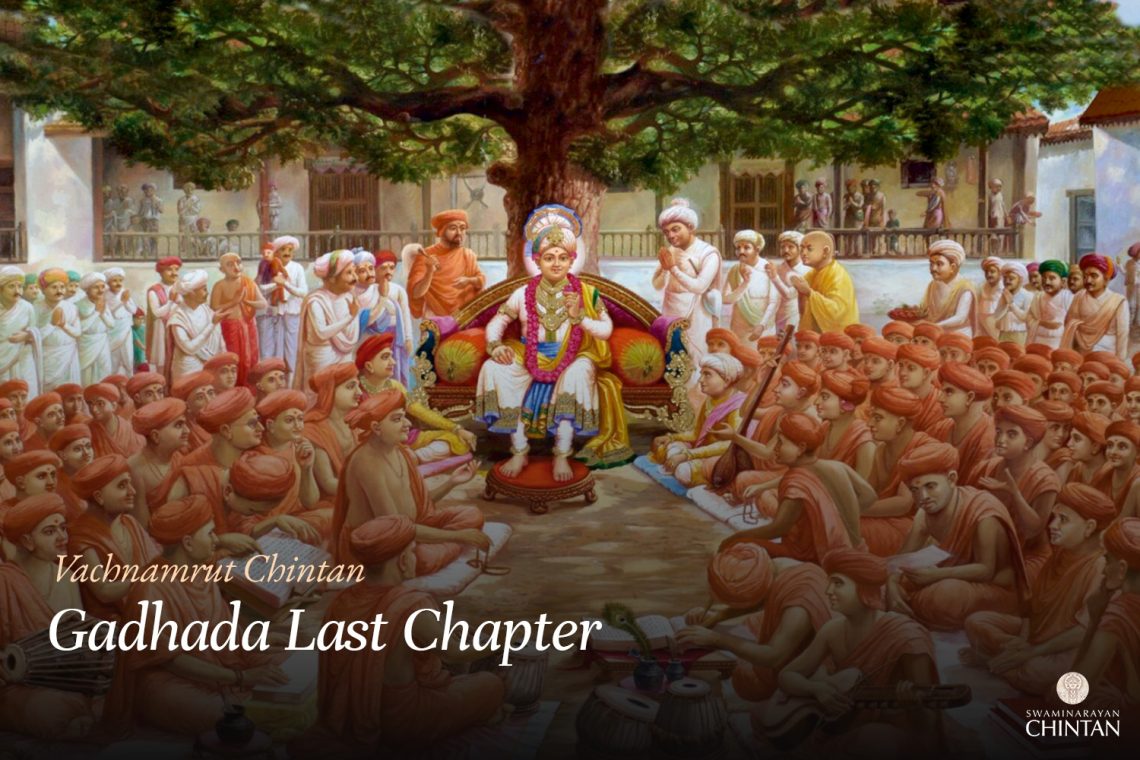Central Insights:
- To ensure uninterrupted bhakti (devotion), one must cultivate firm vairagya (non-attachment) and atmanishtha (faith in one’s Self).
- The aspect of gnan (knowledge) and the aspect of love.
Key Points:
- To avoid interruptions in bhakti during adverse times, places, or circumstances, cultivate vairagya and atmanishtha.
- Devotees with the aspect of gnan comprehend the immense greatness of Bhagwan.
- Devotees with the aspect of love cannot endure even a moment without Bhagwan.
- Devotees possessing both aspects surrender everything for Bhagwan and His devotees.
Explanation:
In this Vachanamrut, Shreeji Maharaj asked the paramhansas a question: If a devotee of Bhagwan encounters unfavorable circumstances, such as an attachment to worldly pleasures in youth, bad company, or exposure to misleading scriptures, what understanding ensures that their bhakti remains undisturbed?
The paramhansas attempted to answer, but Shreeji Maharaj was not satisfied. He explained, “A devotee who worships Bhagwan must possess two qualities: firm vairagya and atmanishtha. Without vairagya, if a person encounters attractive worldly objects, they may develop the same love for those objects as they have for Bhagwan. Similarly, without atmanishtha, when faced with bodily happiness or misery, their mind gets swayed. They will start liking what brings them happiness and disliking what brings them misery. Consequently, their intellect becomes corrupted.”
The two major obstacles in bhakti are greed and suffering. To overcome these, one requires vairagya and atmanishtha. Vairagya helps one see all material forms as false, while atmanishtha eliminates bodily attachment. This ensures that no obstacles arise in bhakti. Without these qualities, even if one experiences nirvikalp samadhi (trance without consciousness), peace and joy last only while in samadhi. Once out of it, like Narayandas, they will act capriciously upon encountering desirable objects.
Further, Maharaj explained that a devotee of Bhagwan is connected to Him either through the aspect of gnan or the aspect of love. A devotee with gnan recognizes the immense greatness of Bhagwan. For instance, Jeenabhai, Devram, and Prabhashankar are examples of devotees with gnan. Jeenabhai served Kamalshibhai of Mangrol, considering him a devotee and appreciating his greatness. Similarly, when Prabhashankar received a letter from Maharaj, he left his wedding incomplete to join Him. This deep understanding of Bhagwan’s greatness connects such devotees to Him through gnan.
Moreover, a devotee with gnan knows Bhagwan as the antaryami (all-knowing indweller). They do not misunderstand Bhagwan’s actions as being influenced by others or question His reprimands. Such clarity of thought signifies the aspect of gnan. Those who doubt Bhagwan’s actions lack both the aspect of gnan and the aspect of love.
A devotee connected through the aspect of love cannot live even a moment without Bhagwan. Out of love, they may go to great lengths, even doing what they ordinarily would not. For example, a thief who loves his family will steal and even kill others to bring wealth home, showing compassion for his family despite being ruthless toward others. Similarly, a devotee with love shows selfless devotion to Bhagwan and His devotees, devoid of jealousy, anger, or criticism. Instead, they maintain a heart full of empathy and solidarity. Such a person exemplifies the aspect of love.
Anyone lacking both gnan and love is like one indulging in trivial, whimsical behavior.
Later that evening, Maharaj said, “All of you—renunciates, brahmacharis, and householders under my shelter—should recite the Shikshapatri that I have written. Those who cannot read should listen to it, and those who lack access to someone to read it should worship it. If none of these three are done, they must observe a fast. This is my command, and it must be followed without fail.”
Glossary
| Vairagya – Detachment From Everything Except God |
| Atmanishtha – Steadfastness in the realization of the soul The firm realization and understanding of the soul’s true nature, living beyond the influence of three kinds of body |
| Gyan – Knowledge |
| Bhakti – Devotion Loving and selfless worship of God. |
| Antaryami – Inner controller The omnipresent form of Bhagwan that resides within all living beings. |
| Nirvikalp Samadhi – A state of perfect absorption or concentration where the mind is undisturbed It is a state of meditation where the individual’s mind is fully absorbed in the object of meditation, without any distractions, and free from worldly attachments. |
| Paramhansa – Supreme Renunciates A highly evolved saint who has renounced all worldly attachments and is solely devoted to God. |
| Gopi Bhav – Mood of the gopis A devotional attitude where the devotee sees themselves as God’s beloved, emulating the devotion of Krishna’s gopis. |
| Bhagwan – God The supreme being who is both transcendental and manifest, bestowing grace upon devotees. |
| Kamalshibhai – A devotee of Bhagwan Swaminarayan |
| Prabhashankar – A devotee of Bhagwan Swaminarayan |
| Jeenabhai – A devotee of Bhagwan Swaminarayan |
| Panch Vishay – Five sensory objects The worldly temptations related to sight, sound, smell, taste, and touch. |

